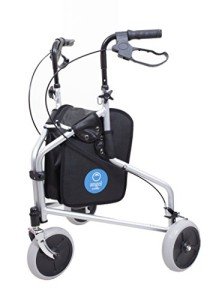3 Common Causes For Why Your Rollator Walker Isn't Working (And How To…
페이지 정보

본문

Rollator Walker Safety: A Comprehensive Guide
As individuals age or face mobility obstacles due to illness or injury, keeping self-reliance typically becomes a concern. Rollator walkers, supplying both support and mobility, have actually ended up being important tools for many. Nevertheless, while they offer many benefits, ensuring safety while using a rollator walker is vital. This short article supplies thorough insights into rollator walker safety, consisting of best practices, common threats, and essential tips for users and caregivers.
Comprehending Rollators
A rollator walker is a mobility device with wheels that allows people to stroll with the support of a frame. Unlike basic walkers, rollators typically feature:
- Three or 4 wheels for easier maneuverability
- Hand brakes for stopping and controlling speed
- A seat for resting when required
- Storage compartments for bring individual products
These functions make rollators appropriate for both indoor and outdoor use, improving the lifestyle for users by providing a sense of self-reliance.
Benefits of Using Rollator Walkers
- Increased Mobility: Rollators can help users in moving securely and comfortably.
- Support and Stability: With a sturdy frame and brakes, they supply essential support when standing or walking.
- Comfort: Many rollators come with cushioned seats, enabling users to rest as needed.
- Convenience: Integrated storage options can bring necessary items, freeing hands for better balance.
Common Hazards Associated with Rollator Walkers
While rollators can enhance mobility and safety, they can also present dangers. Users need to know potential hazards to decrease accidents:
- Uneven Surfaces: Rollators might tip over if used on irregular or sloped terrain.
- Braking Issues: Failing to engage the brakes adequately can lead to falls.
- Excess Weight: Overloading the storage compartments can affect stability.
- Inappropriate Use: Not using the rollator as planned can result in mishaps.
- Poor Maintenance: Neglecting regular checks on wheels and brakes might lead to failure during use.
Rollator Walker Safety Tips
To improve safety while utilizing rollator walkers, think about the following tips:
1. Proper Fit and Adjustment
- Height Adjustment: Ensure that the manage height is set to the user's wrist level when standing upright. An appropriate fit encourages better posture and control.
- Seat Height: If the rollator has a seat, ensure it's comfy and accessible for resting.
2. Routine Maintenance
- Examine Brakes: Make sure hand brakes are operating properly. Change or replace them if required.
- Inspect Wheels: Regularly check wheels for wear and tear, and guarantee they spin freely.
- Examine Frame: Check for loose screws or fractures in the frame to ensure it stays sturdy.
| Upkeep Task | Frequency |
|---|---|
| Brake examine | Weekly |
| Wheel assessment | Month-to-month |
| Frame assessment | Monthly |
3. Environment Awareness
- Clear Pathways: Keep living areas totally free from mess and obstacles that may position a tripping risk.
- Lighting: Ensure that areas are well-lit to avoid missteps, particularly during evening hours.
- Prevent Slippery Floors: Be careful on damp or waxed floorings, as they can result in falls.
4. Safe Walking Techniques
- Engage Brakes When Stopping: Always engage brakes before sitting or while resting.
- Use Proper Walking Technique: Move gradually and preserve a stable speed, taking steps that match the rollator's width.
- Balance While Turning: Turn carefully, utilizing the rollator for assistance as required.
5. Seek Assistance
- Involve Caregivers: Encourage relative or caretakers to assist in navigating tough surfaces or situations.
- Benefit From Community Resources: Many communities provide mobility training for those utilizing walk-assisting gadgets.
Frequently Asked Questions about Rollator Walker Safety
Q1: How do I pick the best rollator walker?
When picking a rollator, think about the user's weight, height, and intended use. It's also necessary to examine for functions such as hand brake effectiveness and wheel size, which can impact maneuverability.
Q2: Can I use a rollator walker on irregular surface areas?
While rollators can manage a range of terrains, it is best to prevent high slopes, gravel, or cobblestones, as these can be hazardous. Stay with flat, smooth surfaces whenever possible.
Q3: How can I avoid falls while using a rollator?
Engaging the brakes when sitting, keeping pathways clear, adjusting your rollator for the appropriate height, and bearing in mind your surroundings can considerably lower the risk of falls.
Q4: Are all rollator walkers the very same?
No, rollators come in various types and sizes, designed for different requirements. Some might have extra devices like baskets, while others are lightweight or feature a higher weight capability.
Q5: Is it safe to bring bags on a rollator?
Always bear in mind the weight limitation and distribution of the load. Use the rollator's designated storage services and avoid overwhelming it.
Rollator walkers are invaluable devices that improve mobility and promote self-reliance for users dealing with mobility challenges. Nevertheless, ensuring safety while utilizing these gadgets is vital. By understanding possible hazards, adhering to safe practices, and preserving the walker regularly, users can take pleasure in the benefits of their rollator with reduced risk. Eventually, the goal is to help with self-confidence and stability, making it possible for people to browse their world with security and ease. As care suppliers, relative, and communities focus on safety, they empower users towards a much better, more independent quality of life.
- 이전글Why Tassimo Coffee Is Your Next Big Obsession 25.06.06
- 다음글This Is How Kids Bunk Bed Will Look In 10 Years 25.06.06
댓글목록
등록된 댓글이 없습니다.

